《孔昭金和他收藏的汉画像砖》
- 2021-01-04 17:33:46
- 点赞量:9666
- 点击量:218052
- 作者:郝连成 Hao Liancheng
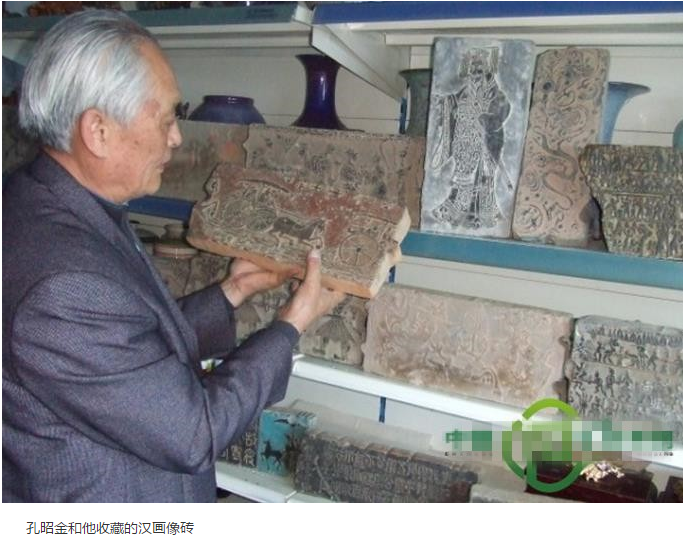
如果说建筑是凝固的音乐,那么砖画就是定格的历史。
If architecture is solidified music, then brick painting is a frozen history.
在北京朝阳区中国画像砖收藏家孔昭金先生的工作室,看到了他收藏的几百块秦汉画像砖的拓印画册后,就更加印证了上述的说法。一九四二年出生的孔昭金是山东省曲阜人,孔子七十二代后裔。幼年生长在传统的儒家文化之中,从小酷爱书法、美术、篆刻,视艺术为生命。早在六十年代就参与国家中草药药典修订,在为药典插图的过程中练就了过硬的素描基本功。在西北行程数万里,足涉昆仑戈壁、羌塘草原、塔克拉玛干、可可西里、唐古拉山,除为美术创作打下了坚实的基础,形成了自己独特的绘画风格,也使他有了接触各地古文物的机会。国内和香港媒体对他的书画成就多有报道,但人们对他在古代陶艺,根艺,秦汉画像砖及其它杂项收藏则知之不多。
In the studio of Mr. Kong Zhaojin, a collector of Chinese portrait bricks in Chaoyang District of Beijing, I saw his collection of hundreds of rubbings of Qin and Han Dynasty portrait bricks, which further confirmed the above statement. Born in 1942, Kong Zhaojin was born in Qufu, Shandong Province. He is a 72 generation descendant of Confucius. Calligraphy and seal cutting grew up in the life of Confucianism. As early as the 1960s, he participated in the revision of the national pharmacopoeia of Chinese herbal medicine, and developed excellent basic skills of sketch in the process of illustration for the Pharmacopoeia. In the northwest, he traveled tens of thousands of miles, including Kunlun Gobi, Qiangtang grassland, Taklimakan, Kekexili and Tanggula Mountain. In addition to laying a solid foundation for art creation, he formed his own unique painting style, which also gave him the opportunity to contact with ancient relics from all over the world. There are many reports about his achievements in calligraphy and painting in domestic and Hong Kong media, but little is known about his collection of ancient ceramics, root art, portrait bricks of Qin and Han Dynasties and other miscellaneous items.

这次看到他收藏的汉画砖实物和几百幅拓印画册,是笔者来访的意外收获。
This time I saw his collection of Han Dynasty bricks and hundreds of rubbings, which was an unexpected result of my visit.
孔先生介绍,汉画文化是指汉代遗留下来的汉画砖、画像石、墓室壁画、石窟石雕、青铜、彝器、陶画、陶文、竹木漆画、木牍、竹简、秦镜、诏版等汉代实物文化。
According to Mr. Kong, Han painting culture refers to the Han Dynasty physical culture left over from the Han Dynasty, such as Han painting bricks, stone reliefs, tomb murals, grotto carvings, bronzes, Yi ware, pottery paintings, pottery inscriptions, bamboo and wood lacquer paintings, wooden slips, bamboo slips, Qin mirrors, and imperial edicts.
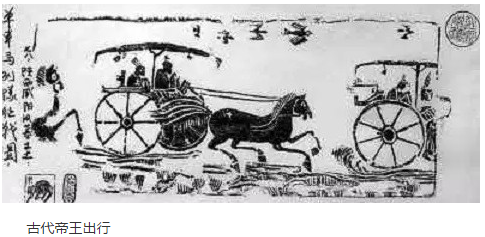
在孔先生展示的拓印中,或有上古时期仙人共舞的神话传说,或有先民们躬耕狩猎的原始生活。有马驰车奔的战场厮杀,也有歌舞升平的宫廷宴饮。
In the rubbings displayed by Mr. Kong, there are some myths and legends about the immortal dancing together in ancient times, or the primitive life of ancestors engaged in farming and hunting. There are battles where horses gallop and cars rush, and palace banquets where people sing and dance.
孔昭金是从1964年到青海省乐都县工作时,看到当地一-座残败的文庙内有孔子和老子等先圣们的残像开始收藏的,当时只是出于对本家宗亲的一种崇敬,不愿让这些先圣暴露于荒野之中,从此收藏的视野越来越宽,收获也越来越多。几十年来,孔昭金收藏了400多块汉砖画像,并拓印成册,在民间收藏者可称绝无仅有。
When Kong Zhaojin went to work in Ledu County of Qinghai Province in 1964, he saw that there were statues of Confucius, Laozi and other sages in a dilapidated Confucian temple. At that time, he began to collect them out of respect for his family, and he didn't want to expose them to the wilderness. From then on, his vision of collecting them became wider and wider, and he gained more and more. For more than 400 years, Kong Zhaohan's rubbings have been a unique collector of gold.
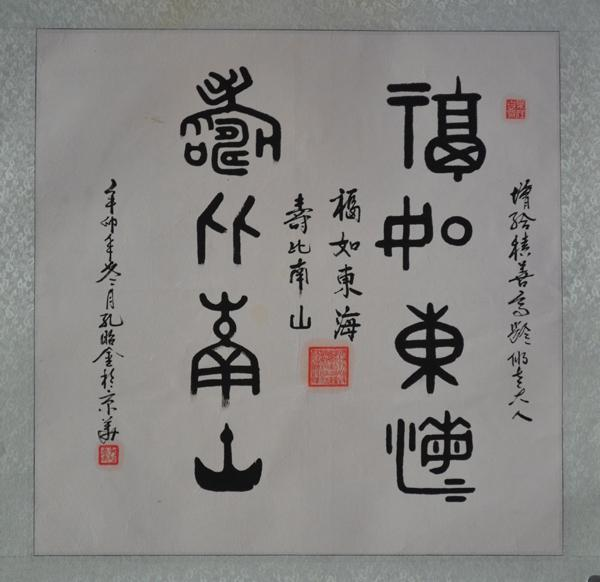
为收藏,孔先生当年不仅花光了所有的工资,还经常碰到尴尬或是危险。
In order to collect, Mr. Kong not only spent all his salary, but also often encountered embarrassment or danger.
1975年,一场洪水将青海省乐都县曲昙寺的灵塔冲倒,并冲出一个马厂文化后期的古墓,彩色的红陶碎片遍地都是,当孔昭金知道消息时已是两个月后。他去后在曲昙寺周边的住户家中均发现有古墓中的陶罐。有的喂鸡,有的盛水,有的栽花,还用古陶充当小便壶,在古墓现场墓门的开口处,有一个“镇”样的雕砖引起了他的兴趣。杂草丛生的墓道内,深处尚有清水,他用改锥试着挖掘,在挖“天镇”状雕砖的瞬间,突然一下刺痛,随即看到一条拇指粗的花蛇钻进古墓的砖缝里,尚有小半截身躯留在外面。心有余悸的孔昭金意识到是被毒蛇咬伤了,求生的本能,紧急自救,先用玻璃片忍着巨痛划开伤口排出血毒后,又用小便冲洗伤口,在草丛中找一棵野甘草用嘴嚼碎敷好用手帕缠住伤口,一路小跑来到曲县寺院,经方丈及时处理才化险为夷。
In 1975, a flood brought down the pagoda of Qutan temple in Ledu County, Qinghai Province, and washed out an ancient tomb of the late Machang culture. Fragments of colored red pottery were everywhere. It was two months later when Kong Zhaojin learned the news. After he went, he found pottery pots from ancient tombs in the homes of the residents around Qutan temple. Some feed chickens, some hold water, some plant flowers, and some use ancient pottery as a urinal pot. At the opening of the tomb gate, a "town" shaped carved brick aroused his interest. There was still water deep in the weedy tomb path. He tried to dig with a screwdriver. When he was digging the "Tianzhen" shaped carved brick, he suddenly felt a sharp pain. Then he saw a snake with thick thumb getting into the crack in the brick of the ancient tomb, and a small half of his body remained outside. Kong Zhaojin realized that he had been bitten by a poisonous snake. He had the instinct to save himself. He cut the wound with a piece of glass to discharge the blood poison. Then he washed the wound with urine. He found a wild licorice in the grass, chewed it with his mouth and wrapped it with a handkerchief. He trotted all the way to the temple in Quxian County, where the abbot dealt with it in time.
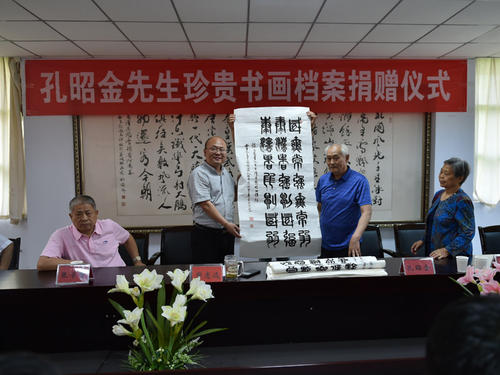
蛇伤没好,又一次去挖那块天镇’"雕砖时,虽然小心地防范着毒蛇,但还是被刺猬把那蛇咬的手臂又刺了一下。两次遭遇,让这个唯心主义者都怀疑莫非这古墓真的有神灵保佑?
When he went to dig the Tianzhen carving brick again, although he carefully guarded against the poisonous snake, he was stabbed by the hedgehog on the snake's arm again. The two encounters made the idealist doubt whether the ancient tomb was really blessed by gods?
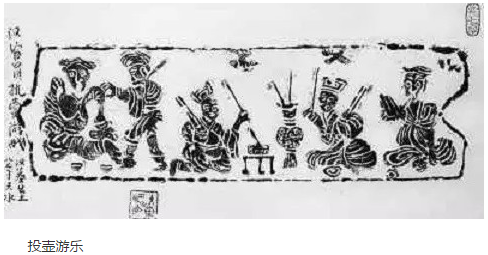
第三次他是趁天没亮时去的,不知是前两次的诚意还是做这事就见不得阳光,这次他很顺利的挖下了七块很不错天镇”雕砖,现已成了世上孤品。
The third time he went there before dawn. I don't know whether it was the sincerity of the first two times or the fact that he couldn't see the sunshine when he did it. This time, he successfully dug seven very good "Tianzhen" carved bricks, which have become the only products in the world.
孔昭金认为,汉画艺术是原始绘画艺术完全成熟的标志,它不但文体早文字古,而且是体现绘画、书法、篆刻于一体的综合艺术,汉砖画像再现了两汉时期的神话传说和那个时代各阶层的生活场景。规格41x18x6公分的《人兽行天图》清晰地表现了上古时期人与鸟兽和谐相处的生态环境,画面中的人兽造型准确,线条生动,并运用了远小近大的透视关系。
Kong Zhaojin believes that Han painting is a symbol of the maturity of the original painting art. It not only has an early style and ancient characters, but also embodies the integrated art of painting, calligraphy and seal cutting. Han brick portraits represent the myths and legends of the Han Dynasty and the life scenes of all walks of life in that era. The 41x18x6cm "the picture of man and beast walking in the sky" clearly shows the ecological environment of harmonious coexistence between man and birds and beasts in ancient times. The shape of man and beast in the picture is accurate, the lines are vivid, and the perspective relationship between far small and near large is used.
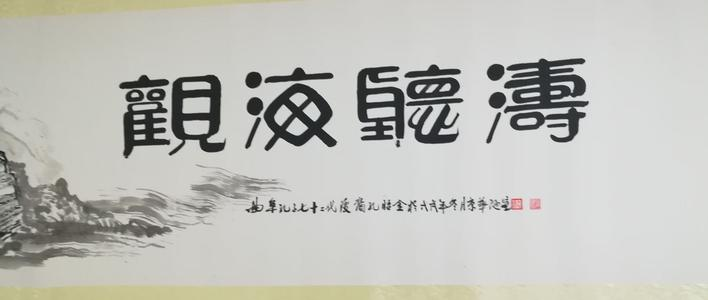
司马迁笔下的《鸿门宴》也成了汉砖画像的创作题材,只是在孔先生收藏的这块汉砖画像中,只有一人在舞剑,不知是项庄还是樊哙。也可能汉代的酒宴都有这样的节目,那么此块砖画表现的就有可能是很普通的一个宴会场面。
I don't know whether the painting of Mr. Fan Hongzhuang is a brick or a sword. It is also possible that there were such programs in the banquets of the Han Dynasty, so this brick painting may represent a very common banquet scene.
1974年在甘肃张掖地区收集到的水陆征战砖画虽然只有0.6平方尺,但画面气势恢宏,场面生动,双方兵士剑刺盾挡,划桨争先的曲态身型无不惟妙惟肖栩栩如生,甚至能让人感觉似有双方厮杀呐喊和兵器相搏的声音从画面透出。
Although the water and land battle brick painting collected in Zhangye area of Gansu Province in 1974 is only 0.6 square feet, the picture is magnificent and vivid. The soldiers of both sides stab the shield block with their swords and fight for the lead in rowing are all lifelike and lifelike. It can even make people feel like the sound of fighting and fighting between the two sides.
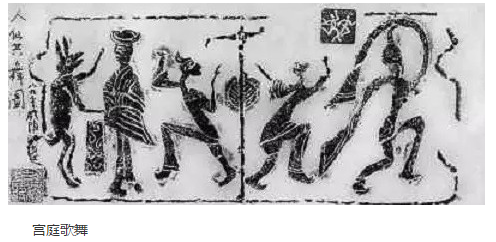
和平是暂时的,战争是永恒的,有人类就有战争,从这幅汉砖画中又一-次得到了印证,看后让人会更加珍惜和平时代。
Peace is temporary, and war is eternal. If there are human beings, there will be war. It has been confirmed again and again from this Han brick painting that people will cherish the peaceful era more.
在孔昭金收藏的汉砖画中,很多是反映当时的衣食住行和日常生活的,饮宴、狩猎、车马出行、博奕、乐舞、百戏、宿相星辰、天神历鬼、农作耕织,各行工匠,林林总总从王侯将相到市并兵民无所不包,正所谓一-图胜千文。
In Kong Zhaojin's collection of Han brick paintings, many of them reflect the basic necessities of life and daily life at that time, such as drinking, dining, hunting, riding, games, music and dance, drama, stars, gods and ghosts, farming and weaving, craftsmen from all walks of life, from Kings and Marquises to soldiers and civilians in the city.
采访孔昭金让我知道了汉砖画,看汉砖画,让我走进了历史,从历史中我看到了中华民族的前行足迹。
Interview with Kong Zhaojin let me know the Han brick painting. Seeing the Han brick painting let me into the history. From the history, I saw the footprints of the Chinese nation.
郝连成2013年5月采写
Written by Hao Liancheng in May 2013
北京朝阳区孔昭金工作室
Kong Zhaojin studio, Chaoyang District, Beijing



雁在蓝天
刘战西